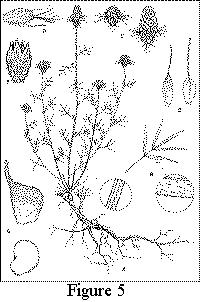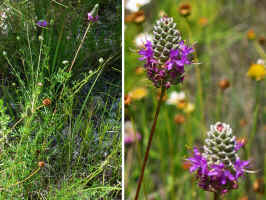![]()
A low, sprawling habit is also exhibited by an endemic species of Dalea,
one of the finds of
the original canoe expedition. Acquainted
with the Baskin and Baskin
(1984) paper discussed
below,
we assumed upon first seeing the Dalea
that we had
rediscovered a species known only historically
from Bibb County, D.
gattingeri. A duplicate from
our first collection, labeled as Dalea gattingeri, was sent to Robert Kral, who determined it instead to be Petalostemon
purpureum (Vent.) Rydb. [=
D. purpurea
Vent.], a finding we found difficult to accept, based on our experience
with the latter
species. Once the first author compared Bibb County material with his
own collections from
elsewhere of D. gattingeri
and D. purpurea,
he concluded that the Bibb County plant could not be
conspecific with either of those taxa. After consultation of the
literature, particularly Wemple (1970)
and Barneby (1977), it became clear that the Ketona Glade plant
differed from any entity previously
described. It is morphologically closest, not to any species already
mentioned, but to a Texas
endemic, D. tenuis
(Coult.) Shinners.
Dalea cahaba J. Allison,
sp. nov. TYPE: Alabama: Bibb County, ca. 20.5 km NE of
Centreville.
"County Road 10 Glade," Ketona Dolomite outcrop ca. 2.0 km ENE of the
mouth of Four Mile
Creek, 1 May 1994, James R.
Allison and Timothy E. Stevens 8236
(holotype, NY; isotypes:
AUA, DUKE, FSU, GA, GH, JSU, MICH, MO, UNA, US, VDB). Figure 5.
5.
Ab aliis speciebus seriei Purpurearum (Rydb.) Barneby, sectionis Kuhnisterae (Lam.) Barneby, combinatione caulium decumbentium cum spicis fructiferis brevibus (longitudine maxima 2.8 cm), bracteis interfloralibus persistentibus inter calyces et dorsaliter pubescentibus per longitudinem carinae praeter corpus abrupte glabrum (quamquam ciliatum) supra positionem latissimam, et ovariis fructibusque dense pilosulis super saltem dimidium distale distinguenda.
Perennial
herb, from a thick (ca. 1 cm),
elongate (normally longer than the aerial portion),
sparingly branched, dark brown root, in age forking at or just below
ground level. Stems
usually
several, 1.7-6.5 (7) dm long, usually
decumbent or weakly ascending, striate-ribbed, pale green,
stramineous, or somewhat reddish or purplish, glabrous or distally
thinly pilosulous with spreading-ascending or somewhat appressed,
weakly curved to sinuous hairs mostly less than 0.3 mm long,
either simple or more often branched proximally (or some short, sterile
branches also produced above
the middle of the stem), the fertile branches monocephalous. Leaves
aromatic in life, green, often
drying gray-green, petiolate, scarcely bicolored, punctate beneath,
rachis and lower (rarely both)
surfaces of leaflets thinly strigillose, the hairs on the petiolules
more divergent; stipules subulate or
the lower lance-acuminate, 1.5-3.5 mm long, primary cauline leaves
1.5-3.7 cm long (including
petiole), with broadly margined rachis and 3 or 5 linear or rarely
linear-oblanceolate, acute, flat and
marginally inrolled or tightly involute leaflets that are 0.5-2.0 cm
long, the terminal one slightly the
longest, on petiolules 0.5-0.8 mm long, the leaves of axillary spurs
shorter, with much smaller,
otherwise
similar leaflets. Inflorescence
a spike on a peduncle (1.5)
2-8.5 cm long
(rarely a single flower borne a few mm below the rest), dense in bud,
loosening only slightly during
and after anthesis, globose to somewhat conelike, becoming
oblong-cylindroid or subglobose, without
petals (7) 9-12 mm in diameter,
the densely pilosulous axis 0.5-2.2
(2.8) cm long; bracts disjointing only with the fruiting calyx,
caudate, dimorphic, the
lowest 4-7 mm long, the body
obovate or lance-obovate, the curving, subulate tail accounting for
half or more of the total
length,
glabrous or pilosulous, the inner ones oblanceolate, 3.5-5 mm long, the
tail accounting for about half
of the total length, densely tomentulose along the keel and margins, at
about the middle of the body
the pubescent area extending toward the margins, distally glabrous
(except for cilia) beginning
0.5-0.75 mm below the tail; calyx 4-5 mm long, 10-ribbed, densely and
very shortly tomentulose,
the hairs sinuous, interwoven, oriented in different directions on the
same calyx, up to 0.35 mm long
or the proximal a little longer, calyx tube subsymmetrically obovoid,
2.5 mm long, not recessed
behind banner, glandless, the teeth subdimorphic, the 3 dorsal ones
lance-acuminate, (1.7) 2-2.5 mm
long, the ventral pair lance-ovate- to ovate-acuminate, (1) 1.4-2 mm
long; petals rose-purple,
eglandular; banner 3.5-5.3 mm long, the claw 1.5-2.8 mm, the ovate
blade 2.0-2.5 mm long, 1.7-1.8
mm wide, hooded at the broadly rounded to slightly emarginate apex,
broadly cuneate to broadly and
shallowly cordate at the base; epistemonous petals 3.5-4.4 mm long, the
blades oblong or oblong-lanceolate, 2.5-3.0 mm long, 1.1-1.8 mm wide,
broadly rounded to rounded-truncate at apex, base
broadly cuneate, claw 1.0-1.4 mm long; androecium 6-7 mm long, the
column 2.2-2.6 mm long, the
filaments free for 4-4.5 mm, the connective gland-tipped, the yellow or
orangish anthers (0.7) 0.9-1.2
mm long. Fruit
a pod, obliquely semi-obovoid in profile, 3.2-4.4 mm long, including
the persistent
style; the ventral suture nearly straight, the dorsal convexly arched,
the style- base eccentrically
terminal, the valves in proximal third hyaline and glabrous, distal
two-thirds thinly papery,
tomentulose; seed brown or olivaceous, 1.9-2.2 (2.4) mm long, (1.2)
1.5-1.7 mm wide at the middle.
Chromosome number unknown.
Flowering May-June; fruiting
June-September.
English Name: Cahaba Prairie-clover.
Paratypes. Alabama: Bibb Co., (topotype), 2 May 1998, A. 10649 (AUA, BRIT, DUKE, FLAS, FSU, IBE, JSU, TAMU, UNA, US, USCH); "Pratts Ferry. Aug.," H.[?] J. Smith s.n. (UNA); 11.9 km NNE of Centreville, "Pratt Glade West," 19 Jul 1992, A. and S. 6876 (AUA, GA, JSU, UNA); 12.2 km NNE of Centreville, "Westside Glade West," 14 Jun 1993, A. and S. 7753 (GA, NY, UNA, US); 14.7 km NE of Centreville, "Brown's Dam South Glade III," 28 May 1994, A. et al. 8338 (AUA, GA, MO, NY, UNA, US, VDB); 14.8 km NE of Centreville, "Riverbend Glade," 13 Jun 1993, A. and S. 7718 (AUA, JSU, UNA);15.3 km NE of Centreville, "Desmond's Glade," 7 Jun 1998, A. 10900 (MO, NY, TENN, US).
Dalea cahaba is present on all of the larger glades but is absent from the smaller ones found near the western periphery of the glade region. Like Coreopsis grandiflora var. inclinata, it is a true heliophyte, flowering only in exposed situations.
As cited among the paratypes, at least one historical collection of Dalea cahaba exists. Baskin and Baskin (1984) refer to three previously unannotated 19th Century Alabama collections at the University of Alabama (UNA), labeled by their collectors as Kuhnistera gattingeri Heller. The Baskins found them all to be Petalostemon gattingeri (Heller) Heller [this and the preceding =Dalea gattingeri], determinations concurred with by the late Duane Isely. Smith's Bibb County collection is, in fact, D. cahaba.(5)
Aside from the strongly
diagnostic transverse band of pubescence on the otherwise glabrous
or glabrescent bodies of the interfloral bracts, Dalea
purpurea is very different in
aspect from the
other three taxa discussed here, since it is commonly an erect or
strongly ascending plant with
polycephalous stems [branched above the middle, each branch terminating
in a spike, as figured in
Barneby (1977) and Isely (1990)]. A wide-ranging species, its
populations geographically closest to
Bibb County are on chalk glades [Mohr's (1901) "bald prairies," as at
Gallion] of the Black Belt
region of the Gulf Coastal Plain of Alabama and Mississippi, where it
is a common plant. Conversely,
D. cahaba,
D. gattingeri,
and D. tenuis
have a decumbent to weakly ascending habit combined with
stems ordinarily branched only below the middle. Rare, decumbent forms
of D. purpurea
have been
reported (Wemple 1970, Barneby 1977), nevertheless referable to that
species on the basis of bract
pubescence and branching pattern.
Dalea gattingeri is a plant of limestone glades of higher latitudes than Bibb County, with its nearest known localities more than 135 km to the north, in Morgan County, Alabama (Kral 1983). It differs markedly from D. cahaba and D. tenuis by its longer, often sinuous spikes (mostly more than 2.5 cm long, reaching as much as 7.5 cm), which loosen during and after anthesis, partially exposing the axis (at least in pressing) and accompanied by the loss of most of the interfloral bracts. Though its spikes are long, its peduncles are short, only 0-3 cm long, while those of D. cahaba and D. tenuis are seldom less than 3 cm long. The antrorse calyx pubescence of D. gattingeri resembles somewhat that of D. purpurea, but its interfloral bract pubescence pattern is more like that of D. cahaba and D. tenuis, except that the tail is pubescent or at least distinctly ciliate, rather than essentially glabrous. Furthermore, D. gattingeri often has 7 or sometimes even 9 leaflets, as shown in its photograph in Duncan and Duncan (1999), rather than the maximum of 5 found in D. cahaba and D. tenuis.
Dalea
tenuis shares with D.
cahaba a decumbent habit,
permanently dense and conelike spikes
mostly less than 2.5 cm long [Barneby 1977, though Wemple (1970) gives
the length to 4.4 cm],
and
a similar pattern of bract pubescence. Morphologically, D.
tenuis stands apart from the
three other
species here discussed by the distinctly retrorse
pubescence of the calyx tube, the almost totally
glabrous ovary (pilosulous only at the style-base), and by its long
peduncles (as much as 15 cm long,
vs. a maximum of 8.5 cm in D.
cahaba). Dalea
cahaba has ovaries and pods
that are densely
tomentulose on at least the distal two-thirds and a distinctive calyx
pubescence, the hairs more
appressed than in its relatives, and peculiar in varying from antrorse
to retrorse in orientation on the
same calyx, sinuous and interwoven, the result a comparatively
disheveled calyx vestiture. A further
difference is found in the calyx teeth, which are often about as
pubescent as the calyx body in
D. cahaba,
usually glabrous or thinly pilosulous (though ciliate) in D.
tenuis.
1977, though Wemple (1970) gives
the length to 4.4 cm],
and
a similar pattern of bract pubescence. Morphologically, D.
tenuis stands apart from the
three other
species here discussed by the distinctly retrorse
pubescence of the calyx tube, the almost totally
glabrous ovary (pilosulous only at the style-base), and by its long
peduncles (as much as 15 cm long,
vs. a maximum of 8.5 cm in D.
cahaba). Dalea
cahaba has ovaries and pods
that are densely
tomentulose on at least the distal two-thirds and a distinctive calyx
pubescence, the hairs more
appressed than in its relatives, and peculiar in varying from antrorse
to retrorse in orientation on the
same calyx, sinuous and interwoven, the result a comparatively
disheveled calyx vestiture. A further
difference is found in the calyx teeth, which are often about as
pubescent as the calyx body in
D. cahaba,
usually glabrous or thinly pilosulous (though ciliate) in D.
tenuis.
A
genetic comparison of Dalea
cahaba and related species
would be desirable, to assess
whether the morphological similarities to the Texas endemic (D.
tenuis) reflect common descent
(indicated by greater genetic similarity to D.
tenuis) or convergence (greater
similarity to D.
gattingeri).